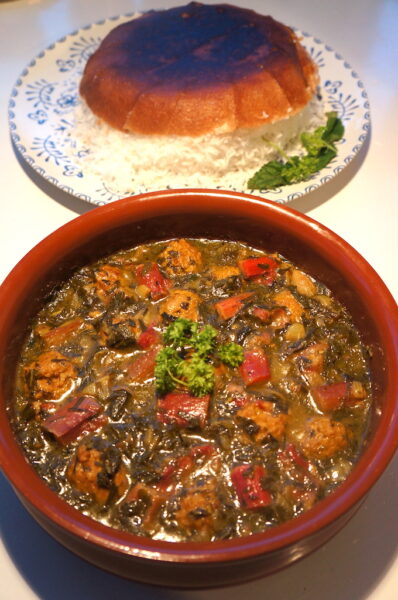Khoresht e Rivas | Iranian Rhubarb Stew | خورشت ریواس
Khoresht e Rivas is the perfect way to use homegrown rhubarb. This Iranian rhubarb stew is savoury and sour, full of vegan protein and super healthy!
History of Rhubarb in Iran
Thought to have originated in China, rhubarb is now eaten around the world. It is valued for various medicinal properties and for being easy to grow. The Persian word for rhubarb, 'ریواس' or 'rivas', is similar to the translations in Arabic, Turkish, Kurdish, and even Russian because they are all influenced by the Ancient Persian word [1]. This suggests that rhubarb was introduced to Iran and then spread to nearby countries through trading, taking the Persian name with it. Now, in Iran and surrounding countries, a wild species (Rheum Ribes) grows on rocky hillsides and is incorporated into the local cuisine to aid digestion as well as for taste. Of course, rhubarb is well known for its strong sour flavour and this matches Iranian cuisine perfectly. Iranian stews (Khoresht) usually use a souring agent such as verjuice, pomegranate juice, or dried lime (which create a balanced flavour when served with rice and tahdig). However, with rhubarb as the main ingredient in Khoresht Rivas, nothing else is needed to give the dish that classic sharp taste. Rheum Ribes is a little sweeter than UK rhubarb and is often eaten raw as well as cooked in jams. Globally, rhubarb has been applied medicinally for many centuries. From improving digestion, to treating a range of physical and psychological disorders. However, the strength of rhubarb can also be seen in its toxicity. As well as the leaves, the stalks also contain oxalates which can cause kidney stones if eaten in abundance.When do you pick rhubarb?
In the UK, early varieties of rhubarb are available from April and some go through to July. Rhubarb is such an easy plant to grow in the garden. To pick, snap off the poisonous leaves and take home the crunchy red/green stalks. The rhubarb on the mountains of Iran can be picked around April. The trip to the hills is not wasted as many other herbs are also usually collected and used for stews and breads.Cooking tips for Khoresht e Rivas
Rhubarb Stew can be made with a variety of protein options instead of meat. If you prefer to cook with whole foods, use kidney or black beans. If you prefer to cook with a meat substitute, you can use any brand of no-meat chunks, no-meatballs, tempeh, seitan... I wouldn't suggest tofu because ingredients with firm texture and extra flavour work better to balance the rhubarb and herbs.- Take your time frying onions (check the oil is hot, add onions, then turn to a low heat) - you can prepare other ingredients while you wait.
- Don't stir the pot once the rhubarb is in - it will break up easily.
- Serve with rice (preferably Iranian style).
References:
- Foust, C. M. (2014). Rhubarb: The wondrous drug. Princeton University Press.

Servings: 4 yield(s)
Ingredients
- 2 tbsp oil
- 2 medium onions (peeled and diced)
- 1 cup fresh chopped mint
- 2 cup fresh chopped parsley
- 1 tsp turmeric
- 500 g cooked kidney beans (2 cans or see other protein options above)
- 2 cup vegetable stock (using a vegetable stock cube)
- salt to taste (depends on stock cube salt )
- 1 tsp black pepper
- 250 g rhubarb stalks (about 1 small stalk per person)
Instructions
- Fry the onion in hot oil on low heat until beginning to brown (10 mins). Then add the mint, parsley, and a little salt. Mix and fry for 2 mins.
- Move the herb mixture to one side of the pan and add the protein to the other side. If you are using beans, they don't need much frying. If you are using substitute meat pieces, add a little more oil and fry until golden brown, adding turmeric towards the end.
- Pour in the vegetable stock, stir, and leave to cook until the liquid has reduced a little (about 10 mins). If you like, add more salt and pepper. Some stock may be salty enough already.
- Slice the rhubarb about 3cm long and add to the pan. Make sure the rhubarb is covered by liquid so it cooks through. You can stir it briefly but then leave it because the rhubarb breaks up easily. Add more water if needed but in the end we don't want too much liquid. Serve on rice (preferably prepared Iranian-style - see above for recipe link).
Recipe Notes
Serve this Rhubarb Stew on traditional Tahdig: soft rice with crispy potatoes. Did you make this recipe? Tag @vegan_middle_east on Instagram or comment below.